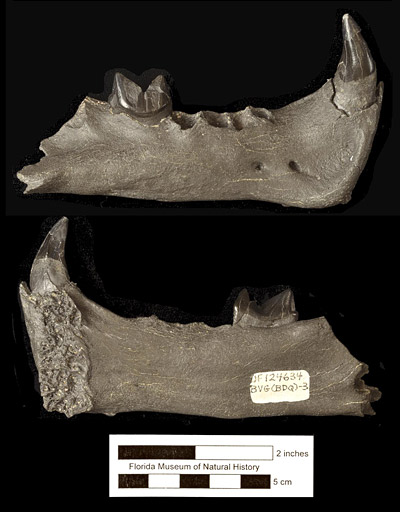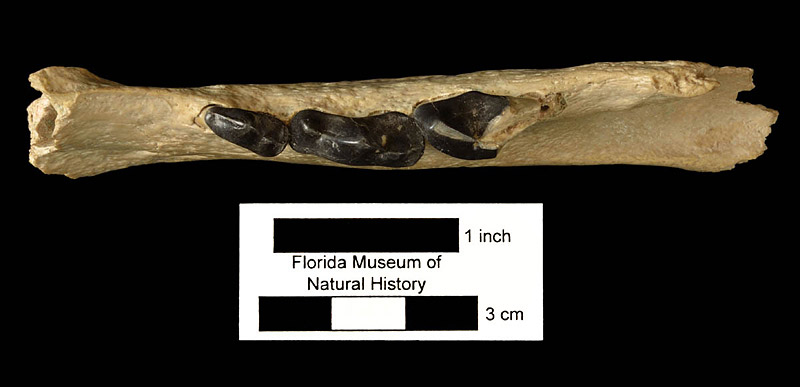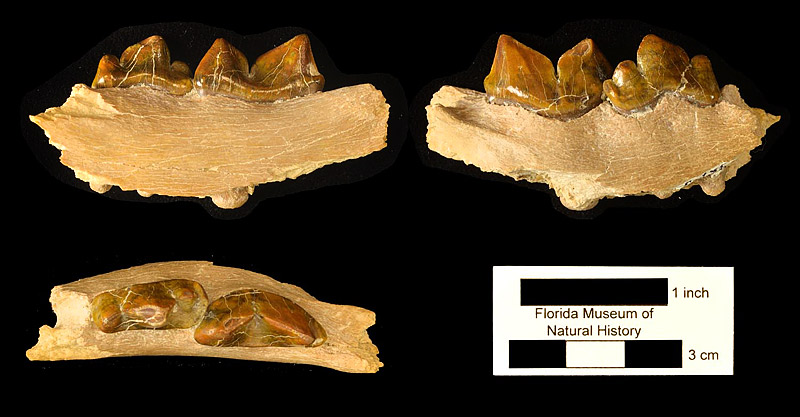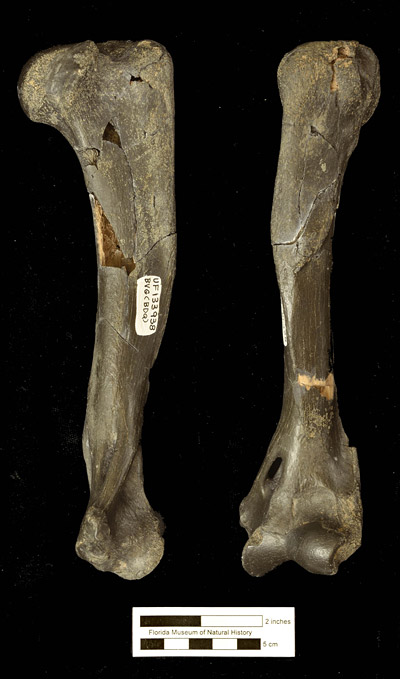Rhizosmilodon fiteae
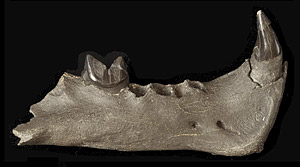
Quick Facts
Common Name: Fite’s saber-tooth cat
Rhizosmilodon fiteae is a small-sized, saber-toothed cat known only from Florida; but most species of felids have large geographic ranges, so it would not be surprising to find its fossils in other areas of North America.
Rhizosmilodon fitae weighed about 165 lbs., the same as a medium-sized, modern jaguar (Panthera onca) or slightly larger than an average modern cougar (Puma concolor).
It was most likely primarily an ambush predator, and probably preferred prey such as deer, peccaries, small tapirs, and small horses.
Age Range
- Early Pliocene Epoch; late Hemphillian land mammal age
- About 4.5 to 5 million years ago
Scientific Name and Classification
Rhizosmilodon fiteae Wallace & Hulbert, 2013
Source of Species Name: named for Barbara Fite of Lutz, Florida, who donated the paratype specimen to the Florida Museum of Natural History.
Classification: Mammalia, Eutheria, Laurasiatheria, Carnivora, Feliformia, Aeluroidea, Felidae, Machairodontinae, Smilodontini
Alternate Species Names: Megantereon hesperus sensu Berta and Galiano (1983)
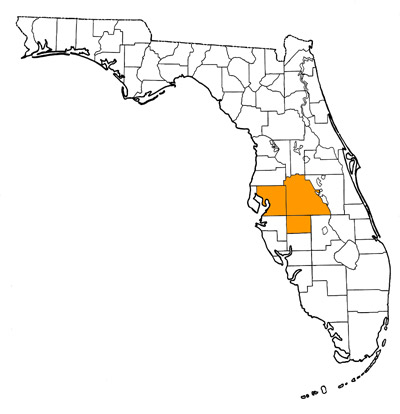
Overall Geographic Range
Rhizosmilodon fiteae is known only from the Central Florida Phosphate Mining Distict, Polk and adjacent counties, Florida. Type locality is the Whidden Creek Site in the Fort Meade Mine of Gardinier, Inc., Polk County, Florida.
Florida Fossil Occurrences
Florida fossil sites with Rhizosmilodon fiteae:
- Hardee County—Fort Green Mine South
- Hillsborough County—Four Corners Mine East
- Polk County—District Grade Mine; Fort Green Mine; Fort Meade Mine (Gardinier); Palmetto Mine; Phosphoria Mine; Rockland Mine (US Steel); TRO Quarry, Payne Creek Mine; Whidden Creek Site, Fort Meade Mine (Gardinier)
Discussion
The first published record of a small-sized, saber-toothed cat from the Central Florida Phosphate Mining District (Bone Valley) was by Berta and Galiano (1983). They referred a single partial mandible to Megantereon hesperus, a species otherwise known only from the Blancan land mammal age in North America. Because the age of the Florida specimen was then the oldest record of the genus Megantereon, Berta and Galiano (1983) inferred that the genus had evolved in North America and subsequently dispersed throughout the Old World. Several later studies called the identification of Berta and Galiano (1983) into question (Turner, 1985; Palqvist et al., 2007; Webb et al., 2008; Hodnett, 2010).

After the publication of Berta and Galiano (1983), about two dozen additional specimens of a small-sized, saber-toothed cat were collected in the phosphate mines of central Florida. These demonstrated that their age was definitely late Hemphillian (earliest Pliocene), and that they were definitely not Megantereon (Webb et al., 2008). Wallace and Hulbert (2013) conducted an analysis of their evolutionary relationships and showed that they did belong in the tribe Smilodontini, and were also the sister taxon to Megantereon and Smilodon (Fig. 2). So, Wallace and Hulbert (2013) formally named this cat Rhizosmilodon fitae. It is not known to occur in other areas, but most species of felids have large geographic ranges, so it would not be surprising to find its fossils in other areas of North America. It is the oldest known member of the tribe Smilodontini.
Rhizosmilodon fitae is best known from its mandible and lower teeth (Figs. 4-6). They show a mixture of primitive features found in Miocene machairodontines from Eurasia, such as Paramachaerodus, and derived features found in Smilodon and Megantereon. Among its primitive traits are relatively large lower canines and third premolar (p3) teeth, relatively small incisors that do not jut out beyond the lower canines, fourth premolar (p4) with small anterior and posterior accessory cusps, and very small mandibular flange. Among its derived traits are p3 and p4 with strong posterior lean; long axes of p4 and first molar (m1) offset, not aligned with each other; a short, robust m1; and lower canine laterally compressed.
Sources
- Original Author(s): Richard C. Hulbert Jr.
- Original Completion Date: May 1, 2013
- Editor(s) Name(s): Richard C. Hulbert Jr. and Natali Valdes
- Last Updated On: March 3, 2015
This material is based upon work supported by the National Science Foundation under Grant Number CSBR 1203222, Jonathan Bloch, Principal Investigator. Any opinions, findings, and conclusions or recommendations expressed in this material are those of the author(s) and do not necessarily reflect the views of the National Science Foundation.
Copyright © Florida Museum of Natural History, University of Florida
